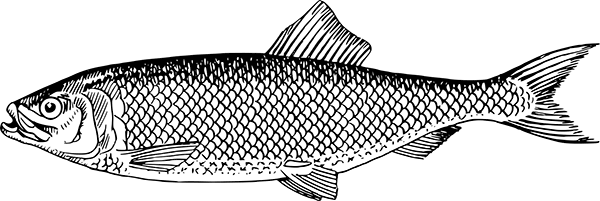Oh! The kipper! One of the greatest inventions of the Railway Age! Its Northumbrian origins, preparation, variety and history explored
KIPPER
The kipper is a gutted and split herring, lightly to moderately salted and cold smoked.
Origins
It was first created by John Woodger at Seahouses in Northumberland in 1843. As with the red herring, from which it derives, it has an origin myth of accidental discovery – a herring, presumably split ready for filleting or frying or grilling, left overnight in a room with a smoky stove.
Like the Yarmouth bloater, however, the kipper was a deliberate product of the railway age.
The red herring cure, along with its associates, was developed to preserve the fish for up to a year or so in more-or-less any climate. It involves heavy salting and heavy cold smoking. The speed of the railways meant that an inland population could be offered something milder, something more subtly flavoured, that could be eaten without soaking.
Kippering salmon was already common – a larger and fatter fish, splitting it enabled the salt and the smoke to penetrate the fish more efficiently. The word considerably predates the object of affection it became.
The Yarmouth bloater seems to have appeared a little before the Seahouses kipper, but they both arrived in advance of a convenient railway station.
Woodger addressed this by developing production in North Shields and then in Great Yarmouth. When I visited the Yarmouth smoker HS Fishing in the late 1990s, they claimed to be direct descendants of the operation he established there – it having merged with that of Henry Sutton.
Back on the North Northumberland coast, Robson’s of Craster trace their origins back to the first kipper. Swallow Fish of Seahouses produce their kippers in the original smokehouses, which have operated on this site since 1843.
The glory of the kipper has been in its diversity, however. Beautiful examples are created, not only in Seahouses, Craster and Great Yarmouth, but along the South Coast, all the way up the East Coast, in Scotland, in the Isle of Man and down the West Coast of England and Wales.
The sweet diversity derives not just from the variations in curing, but from the distinct qualities of the different inshore and off shore herring populations being kippered. Problems with supply since the North Sea fishery collapse of the 70s (and the more recent sale of English herring quotas to a Dutch company) mean that many of the larger kippers are made with Norwegian herrings.
Cold Smoking
Used for kippers, bloaters, red, golden and silver herring, cold smoking involves placing the herring at a sufficient distance from a slow fire, either through the height of the smokehouse or through the construction of a shallow sloped chimney.
Slow burning is often achieved through the use of both sawdust and woodchips. The temperature of the smoke does not normally exceed 85ºF (29.5ºC). Hardwoods are preferred.
Most traditional smokers use oak and/or beech. Coniferous woods tend to be avoided because of their high resin content, although, in the words of an old Lowestoft smoker I once interviewed, ‘Oak-smoked’ covers a multitude of sins. The ratio of oak to other woods in the fire can fall as low as 1:10, apparently. He himself liked to use a bit of pine in his ‘oak smoke’ to give the fish an almost varnished appearance.
Natural vs Dyed
Purists tend to go for the undyed or natural kipper. The fullest account I have discovered of the origins of dyeing the fish comes in Christopher Unsworth’s excellent The British Herring Industry: The Steam Drifter Years 1900 – 1960 (2013). The absence of explanation in most of the source books is largely due to the fact that the majority were written before the practice was initiated.
What was called the Painted Lady first appeared in the First World War. There was a shortage of herrings. Curers sold kippers by weight. Cutting down smoking time meant less moisture – and therefore weight – was lost. They were able to get an extra 12 ½% of kippers from the fresh herrings they bought.
The rich red brown of a traditional kipper derives from the length of smoking. Less smoke resulted in a more pallid appearance, so the curers painted them with dye to reassure customers they were the genuine article – even though they weren’t. Originally this was widely done with a coal tar-based dye, Brown FK (For Kippers), but too much of this isn’t good for you – EU legislation limits the ADI (Acceptable Daily Intake) to 0.15 mg/kg.
Dyed kippers today are coloured with Annato, a natural product derived from the seeds of the achiote tree. Brought to Europe from the Americas in the C16th – and used in the making of Double Gloucester cheese since then – it may have been used by some herring curers from the early days of kipper painting.
In recent years the public taste has moved towards ever milder salting and smoking. ‘Natural oak-smoked kippers’ are sought after, their paleness a signifier of a more subtle flavour. Some people have even begun to avoid undyed, but more heavily-smoked kippers, because from their deeper colouring they assume them to be dyed.
See also
- BLACK HERRING
- BLOATER
- BUCKLING
- CANNING
- DRIED HERRING
- DUMAS ON HERRING
- FISH FINGERS
- GOLDEN HERRING
- GREEN HERRING
- HARENG SAUR
- HARENG SAUR MONOLOGUES
- HERRING BHURTA
- HERRING UNDER A FUR COAT
- IDDIKETTS OR IDDIS
- NASHES LENTEN STUFFE
- OLIVIER, LAURENCE
- PICKELHERING
- RED HERRING
- RED HERRING JOKE, THE
- RING NET: WILL MACLEAN
- RING NETTING
- ROLLMOPS & BISMARCKS
- SALT
- SCHMALTZ HERRING
- SILVER HERRING
- SURSTRÖMMING
- WHITE HERRING
